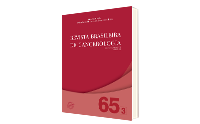Low Levels of High-density Lipoprotein in Patients with Pediatric Cancer at Diagnosis
DOI:
https://doi.org/10.32635/2176-9745.RBC.2019v65n3.528Keywords:
Triglycerides/blood, Cholesterol, HDL/blood, Blood Glucose, Serum Albumin, NeoplasmsAbstract
Introduction: Cancer patients have metabolic imbalances due to the disease, treatment and their complications. Increases in triglycerides and glucose profile and catabolism of protein have been described and are associated with inflammatory response as result of the tumor activity or necrosis. Objective: To evaluate the blood lipid, lipoproteins, glucose and albumin levels in pediatric cancer patients at diagnosis. Method: Observational cross-sectional study. The inclusion criteria were children and adolescents with newly diagnosed malignancies and blood analysis results. The exclusion criteria were: previous anticancer therapy or surgical treatment, blood sample not collected and patients who refused to participate in the study. Results: It were evaluated 81 children and adolescents with newly diagnosed malignancies. There was decrease of 56% and 41% of high-density lipoprotein cholesterol (HDL-C) and triglycerides (TG), 14% and 10% of albumin and glucose, and 10% and 7.6% of total cholesterol (TC) and low-density lipoprotein cholesterol (LDL-C), respectively, for the patients. HDL-C showed statistical differences between solid and hematological cancer patients (p < 0.05). The means and medians of albumin, glucose, HDL-C and TG demonstrated that hematological patients are more prone to metabolic disturbances. HDL-C in this group was 24 ± 12 versus 40 ± 15mg/dl in other cancers. Conclusion: The primary result found in the present study was in HDL-C, mainly in patients with hematological and metastatic cancer. These disturbances could be associated with cancer-related acute inflammatory response.
Downloads
Downloads
Published
How to Cite
Issue
Section
License
Os direitos morais e intelectuais dos artigos pertencem aos respectivos autores, que concedem à RBC o direito de publicação.

This work is licensed under a Creative Commons Attribution 4.0 International License.









